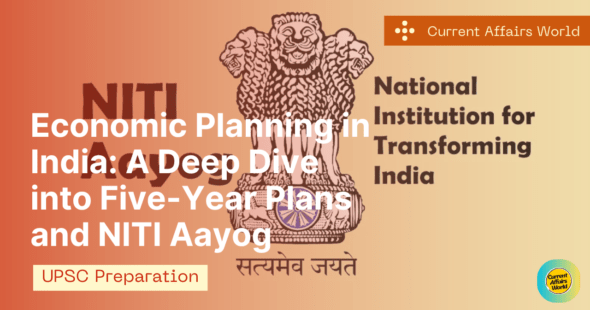Five-Year Plans: History, Objectives, and Outcomes
First Five-Year Plan (1951-1956): Focus on agriculture and irrigation.
Second Five-Year Plan (1956-1961): Emphasis on industrialization.
Third Five-Year Plan (1961-1966): Self-reliance and food security.
Fourth Five-Year Plan (1969-1974): Growth with stability.
Fifth Five-Year Plan (1974-1978): Poverty alleviation and self-reliance.
Sixth Five-Year Plan (1980-1985): Economic liberalization and infrastructure.
Seventh Five-Year Plan (1985-1990): Employment generation and technology.
Eighth Five-Year Plan (1992-1997): Human development and privatization.
Ninth Five-Year Plan (1997-2002): Social justice and equality.
Tenth Five-Year Plan (2002-2007): Inclusive growth and education.
Eleventh Five-Year Plan (2007-2012): Faster and more inclusive growth.
Twelfth Five-Year Plan (2012-2017): Sustainable development and infrastructure.
2. NITI Aayog: Role, Functions, and Impact
Establishment: Replacing the Planning Commission in 2015.
Role: Policy think tank and advisory body.
Functions: Cooperative federalism, strategic planning, and innovation.
Impact: Transforming India’s economic policy framework.
The First Five-Year Plan was launched in 1951, shortly after India gained independence. The primary focus of this plan was to address the immediate challenges of food shortages, poverty, and low agricultural productivity. The plan emphasized the development of agriculture, irrigation, and energy sectors to lay the foundation for a self-reliant economy.
Objectives of the First Five-Year Plan
- Agricultural Development: Increase food production to ensure food security.
- Irrigation Project: Expand irrigation facilities to support agriculture.
- Energy Infrastructure: Develop power and energy resources for industrialization.
Outcomes of the First Five-Year Plan
The First Five-Year Plan achieved significant success in increasing agricultural output and laying the groundwork for future economic growth. The plan’s emphasis on irrigation and energy infrastructure helped boost productivity and set the stage for subsequent plans.
NITI Aayog: Role and Functions
NITI Aayog, or the National Institution for Transforming India, was established on January 1, 2015, to replace the Planning Commission. It was created to foster cooperative federalism and provide a platform for states to actively participate in the economic policy-making process.
Role of NITI Aayog
- Policy Formulation: Designing strategic and long-term policies for sustainable development.
- Monitoring and Evaluation: Tracking the implementation of policies and programs.
- Innovation and Technology: Promoting innovation and technological advancements.
Functions of NITI Aayog
NITI Aayog functions as a think tank, providing both directional and policy inputs to the government. It also acts as a bridge between the central and state governments, ensuring that economic planning is inclusive and collaborative.
Frequently Asked Questions (FAQs)
What were the key objectives of the First Five-Year Plan?
The key objectives of the First Five-Year Plan were to increase agricultural production, expand irrigation facilities, and develop energy infrastructure to support industrialization and ensure food security.
How did NITI Aayog replace the Planning Commission?
NITI Aayog replaced the Planning Commission in 2015 to adopt a more decentralized and inclusive approach to economic planning. Unlike the Planning Commission, NITI Aayog emphasizes cooperative federalism and active participation of states in policy-making.
What is the significance of cooperative federalism in NITI Aayog?
Cooperative federalism ensures that states have a greater say in economic planning and policy formulation. This approach promotes inclusivity, collaboration, and balanced regional development.


